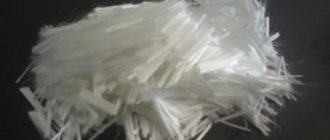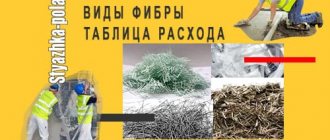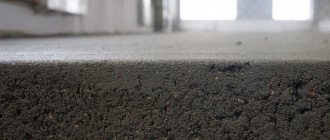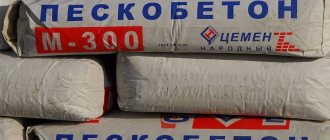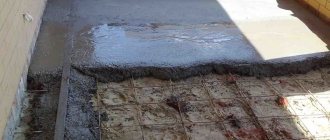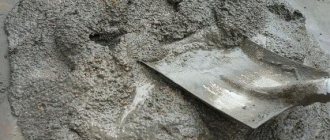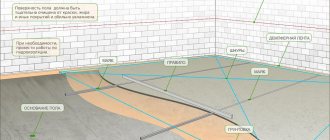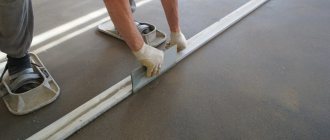Standard solutions that are used for floor screed have a number of disadvantages. The leveling composition based on cement and sand is subject to fairly rapid shrinkage, due to which cracks form on the surface of the concrete slab and the base becomes less durable. To ensure that the flooring remains resistant to loads, the screed is reinforced. However, the use of an additional reinforcing layer increases the weight and thickness of the coating, and also complicates the work. To strengthen the concrete slab, today fiber is used for screeding, which increases the service life of the leveling cement-sand flooring.
What is fiber fiber
Fiber (or fiber) is an artificial material in the form of very thin fibers with a length of 1.5 to 45 mm, which is a modern alternative to standard reinforcement using metal mesh.
This material is made based on the following components:
- Become. Steel fiber has good frost resistance, so it is often used for monolithic structures. However, the weight of such fiber, compared to analogues, is significantly higher.
- Glass. Fiberglass is more often used for facade finishing of buildings, as it has high elasticity, making it possible to produce concrete products of complex shapes.
- Asbestos. This material is also suitable for finishing external walls; it is used very rarely for interior work.
- Basalt. Basalt fiber is highly impact resistant. This material is most often used for foundations that bear increased load.
- Polypropylene. Polypropylene fibers are lightweight, resistant to chemically aggressive substances and temperature changes. In addition, polypropylene does not conduct electricity, so this material is considered optimal for both underfloor heating screed and standard leveling coating.
It is best to use polypropylene fiber for floor screed.
Tools for work
Before you start reinforcing the floor screed with fiberglass, you need to take care of the tools. In your work you will need: cement, sand, fiber, aluminum profile, level and ruler, usually a tape measure, spatula, a tool for mixing the solution (drill, pneumatic blower), knife, screws, screwdriver. Sea sand should be used, size 2.6-3, cement with grade 400 or 500. In addition to fiber, you need to use an additive that plasticizes the mixture.
Tool for screeding fiber-fiber floors
Properties of polypropylene fiber
Fiber fiber made from composite material (C3H6) has the following characteristics:
- fiber length 6-18 mm;
- diameter from 10 to 20 microns;
- tensile strength from 170 to 260 MPa;
- density 0.91 g/cm3;
- ignition temperature of at least 320 0C;
- elongation at break 150-250%.
In addition, the use of polypropylene fiber for floor screed will increase the resistance of the concrete base to solvents, salts, acids, alkalis and other substances.
Types of fiber fiber and their characteristics
Manufacturers of building materials have launched the production of several types of fiber fiber. They differ in material of manufacture and purpose.
Fiberglass
In the production of this type of soft reinforcement, zirconium is used. This material does not rot, has excellent corrosion resistance and does not produce harmful fumes. Glass fiber is produced up to 18 mm long and up to 10 mm thick.
Glass fiber is added to plaster mortars, in mixtures for the preparation of foam concrete and aerated concrete blocks, and is used for casting decorative products and soundproof barriers. The main feature of glass fiber is its ability to maintain the integrity of thin (up to 3 cm) layers of concrete.
Recommended consumption per m3 is 900 grams. Fiberglass is classified as a material in the middle price category and is not used for organizing screeds.
Steel fiber
To produce this product, thin high-carbon steel wire is used. The thickness varies from 0.2 to 1.2 mm, and the length &mdsah; from 5 mm to 150 mm.
Steel fiber fiber is used for the construction of monolithic reinforced concrete structures intended for the construction of critical industrial facilities (bridges, runways, fortifications).
It is not recommended to use steel fiber for screeds, since in thin layers the metal fiber causes local ruptures. This process occurs due to different coefficients of expansion of materials at the moment of temperature change.
The use of steel fiber fiber allows you to achieve the following advantages:
- labor costs are reduced by almost a third;
- the cost of the product is reduced to 7%;
- the bending resistance of concrete increases by 2 times.
Significant disadvantages that arise when using steel fiber include reduced noise absorption of the concrete base. Up to 50 kilograms of steel fiber must be added per cubic meter of mixture.
Basalt fiber
It is made by melting rocks at high temperatures. Basalt fibers are produced with a thickness of up to 500 microns and a length of up to 15 cm. This material for organizing the reinforcement of concrete solutions is considered the most suitable for construction work. It allows you to achieve the following improvements:
- resistance to shock loads increases 5 times;
- bending resistance increases by 3 times;
- resistance to compression and stretching is improved by 1.5 times;
- frost resistance increases by 2 times;
- water resistance improves 1.5 times;
- abrasion resistance is improved by 3 times.
Basalt fiber consumption is up to 2.3 kg per m3.
Polypropylene fiber
Obtained by extrusion of polypropylene mass, as a result of which individual fibers up to 20 microns thick and up to 20 mm long are obtained. The use of this material for reinforcing screeds slightly increases the strength characteristics of concrete, but the positive aspects of using polypropylene fiber include improved sound insulation.
In construction, polypropylene fiber is used for floor screed. Consumption per m2 is determined by recalculating the required volume per cubic meter of concrete, which is up to 900 grams per 1 m3.
Advantages of fiber when laying screed
If you use an anti-shrink mesh to reinforce the screed, then over time it will lose its qualities - it will begin to rust and oxidize, due to which the steel rods will delaminate and deformation of the reinforcing frame will occur. In addition, it significantly makes the screed heavier.
Healthy! According to British Standards, the use of steel mesh for reinforcement is generally not recommended.
Fiber fiber for floor screed, unlike standard products, is free of such disadvantages, since polypropylene fiber retains all its properties throughout its entire service life. In addition, this material has the following advantages:
- Increases the strength of the screed by up to 90% (taking into account that plasticizing additives were also introduced into the cement-concrete mortar).
- Firba is compatible with any building materials and does not change its physical and chemical properties upon contact with moisture or chemicals.
- Micro-reinforcing additive is used for plastering work, where the use of reinforcing metal frames becomes impossible.
- Does not place increased load on fragile floors (for example, in an old house).
- Eliminates the appearance of cracks in the concrete base.
- Reduces moisture absorption by concrete and increases its plasticity.
In addition, floor screed with fiberglass is much faster and easier than leveling with a reinforcing layer.
To fill such a floor yourself, you first need to calculate how much fiber you will need.
What is fiber used for?
Using fiberglass in a floor screed allows you to obtain the following advantages:
- It prevents the mixture from spreading, keeping it “in a pile.” Fiber fiber allows you to reduce the water content in the mixture, it is needed only for dehydration of cement, this “option” prevents the screed from cracking;
- Increases service life;
- Improves the characteristics of the surface, it becomes reinforced;
- Increases abrasion resistance and impact resistance;
- Reduces the level of water absorption, the floor with such a screed does not settle;
- Improves frost resistance and fire resistance characteristics;
- The price of the screed is competitive, regardless of its thickness. When using fiber fibers, steel reinforced mesh can be eliminated.
Fiber consumption
It is generally accepted that the more fiber there is in the cement-sand mortar, the stronger the finished structure will be, so it is recommended to add this component in the following quantity:
| Fiber weight based on g/m3 | Result |
| 300 | The cement mortar becomes more plastic, thanks to which it will fill all the unevenness of the base |
| 500-600 | The strength of concrete and, accordingly, the entire coating will increase. After drying, there will be no cracks on the surface |
| 800 | The concrete mixture reaches maximum strength |
However, it is also worth considering the length of the fiber fibers. Depending on this, the component is suitable for different types of work, namely:
- Fibers 6mm long are suitable for cladding or masonry.
- Fiber fiber 12 mm long is suitable for monolithic structures and concrete screeds.
- Fiber 18 mm long is recommended for use in the manufacture of semi-dry screeds and for repair compounds.
Regardless of the length of the fibers, the price of fiber fiber will be the same, so you can safely choose components with a length of 12 mm or 18 mm, which are optimal for making your own screed without using massive steel mesh.
What is fiber for concrete or mortar?
Let's start with what fiber fiber is. This is one of the types of additives for changing the properties of concrete. Fiber - artificial fibers for concrete reinforcement. It is used as an additive during mixing and is evenly distributed throughout the entire volume. This additive reduces the number of cracks and improves bending strength - these are properties inherent in almost all fiber additives. But the specific properties depend on what material the fibers are made of.
Fiber for concrete is a fibrous additive for improving/changing the properties of the solution
Concrete with the addition of fiber is usually called fiber-reinforced concrete. There are also names that reflect the specific type of additive: basalt fiber reinforced concrete, glass fiber reinforced concrete.
How to make a semi-dry screed with added fiber
To ensure a reliable fiber screed, it is necessary to fill it in the following order:
- Prepare the surface by cleaning it and filling any cracks with putty. Crush large concrete “growths” with a hammer drill.
- Lay a layer of thermal insulation.
- Install beacons on the floor surface. To do this, you can use metal or wooden slats, along which you can level the height of the screed. Lighthouses can also be made from “heaps” of cement mixture.
- Prepare the solution. To do this, mix cement and sand in a ratio of 1:3 and add fiber fiber in a volume of 500-800 g/m3 to the dry mixture, and thoroughly mix all the “ingredients” again. After this, you can add the required amount of water to the solution to obtain a semi-dry mixture.
- Fill the floor with a solution at least 30-50 mm thick.
- Level the poured solution along the beacons using the rule.
- If you plan to lay a layer of finishing screed, first wait until the rough base has completely dried, and then treat the surface with a primer.
- While the screed is still wet, sand the surface.
- Cut expansion joints using a simple cutter. The depth of the seams should be from 1/4 to 1/3 of the total height of the screed. If you do not have the opportunity to cut the seams immediately after grinding, then you can do them on a dry screed (but no later than 24 hours after pouring the concrete).
- To ensure that the screed “seizes” correctly, cover it with polyethylene. If the room is very hot, it is recommended to moisten the floor surface with water at least once a day.
- You can walk on the surface after 12 hours, and after 4-5 days you can lay laminate or other flooring.
Fiber fiber for screed - consumption per m2 is calculated according to its need per m3
Thin polypropylene fibers of short length can significantly strengthen the cement layer, making it more durable and ductile. Regardless of the percentage of the mixture and for what specific purposes the fiber screed will be used, the consumption per m2 of the surface to be laid is determined according to generally accepted figures relating to the amount of fiber for 1 m3 of solution. The calculation is made taking into account the thickness of the concrete layer and the area of the room being equipped.
How to use fiberglass for floor screed and how much is needed per 1 m2?
During the construction process, it becomes necessary to carry out activities to fill the screed. The use of concrete and cement mortars prepared according to standard recipes has weaknesses. The cement-sand composition for leveling the base is prone to shrinkage, which causes cracking and a decrease in the strength of the floor. To increase the load capacity, mesh reinforcement is performed, the use of which increases the weight of the base. An alternative option is fiberglass screed, which strengthens the concrete surface and prolongs its service life.
Why add a reinforced layer?
Cement screed is not reliable and over time, under the influence of various factors, it begins to crumble and become covered with cracks. Its ideally flat surface is achieved with great effort. To facilitate this work, a reinforced layer is first laid on the treated area, often a steel mesh is used for this. But on large areas it does not help create a flat surface. It is for these purposes that polypropylene fiber is used; it costs less than its steel counterpart and is mixed together with cement. Its structure is compatible with all additives used to create concrete.
Technical characteristics of cement-lime mortar grade 75 are given in this article.
The video shows a fiber reinforced screed:
What is the composition of the mortar for plastering walls is indicated here.
The quality of such a solution depends on homogeneity - all particles must be evenly mixed together. This is achieved by portionwise introduction of fiber into the composition. The best method is to mix part of the material with a dry cement mixture, and then mix it with water and then adjust the solution to the desired consistency. The fiber fills all the voids and prevents the cement material from hardening in pieces. The quality of the resulting screed directly depends on its volume used.
